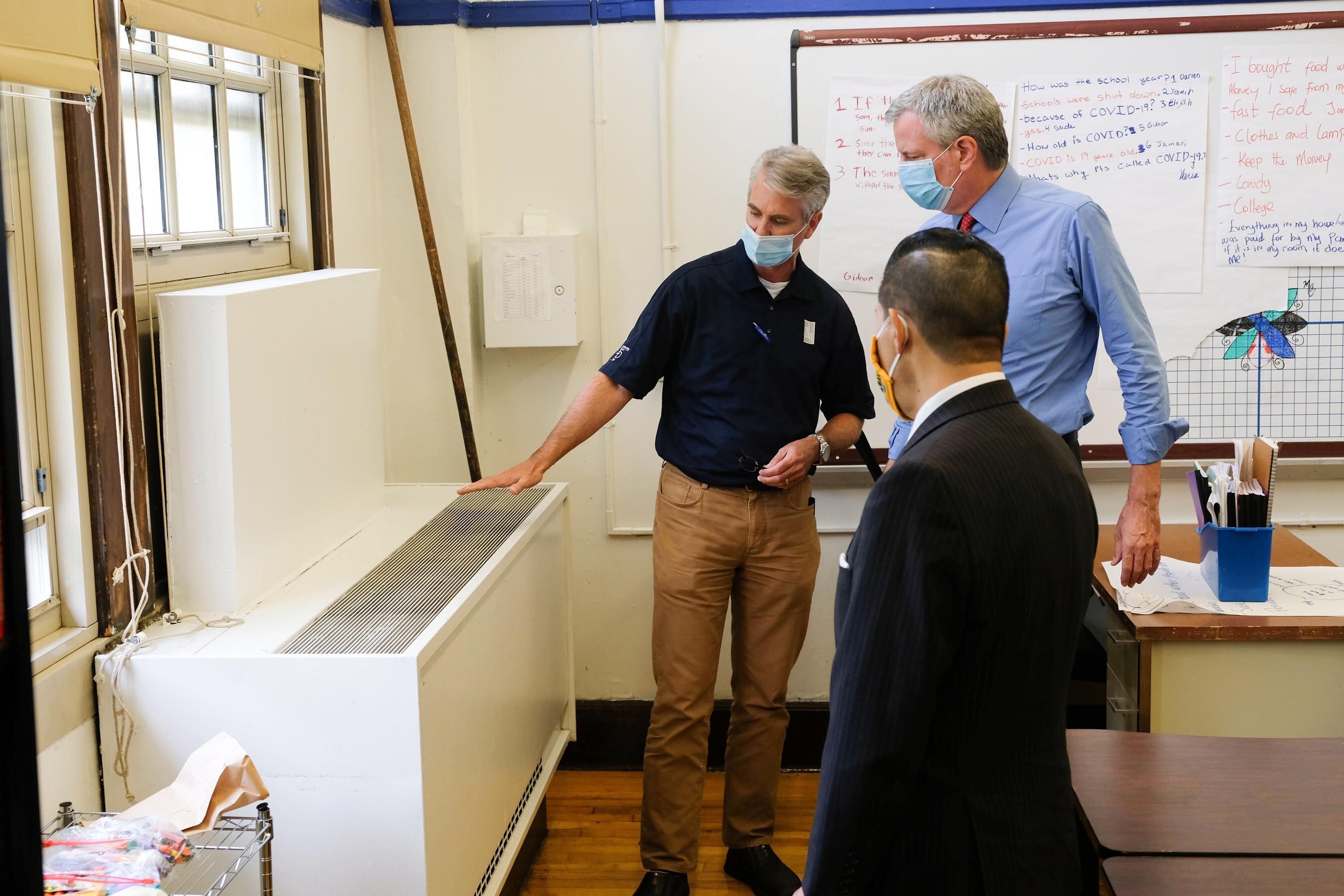Education department officials say they’ve purchased 30,000 HEPA purifiers and have already distributed half of those to school buildings. But hundreds of school staffers are filling in the gaps on their own.
In New York City, crowdfunding efforts through DonorsChoose have brought in $159,000 for air purifiers, according to a spokesperson for the platform that connects teachers in high needs areas to donors. These roughly 360 micro-funding campaigns point to deep distrust of a school system long plagued by ventilation problems as well as the burden on teachers to fund classroom needs out-of-pocket. (Some of the requests also included extra filters, more PPE, and art supplies.)
They also raise larger questions about safety and equity, as the ad hoc fundraising campaigns don’t address systemwide problems, and some schools with better-off PTAs have already mobilized to fill in gaps. While some teachers resort to crowdfunding, other schools have been able to tap their well-resourced parent organizations. Brooklyn Heights’ P.S. 8 and Bard Early College High School in Manhattan, for instance, were able to raise money among parents to buy air purifiers for all classrooms.
“My students are from the South Bronx, and they are resilient, funny, wildly creative, and genuine,” a teacher from Fannie Lou Hamer Freedom High School, wrote on DonorsChoose. “They are also extremely vulnerable, being from the poorest congressional school district in the country and the hardest hit neighborhood from COVID in all of New York.”
Her successful $543 campaign for a HEPA purifier noted that her students would be in that room for most of the day. During the coronavirus pandemic, schedules have been reconfigured so that most students learn from a single classroom for the majority of their 5.5-hour school day.
A teacher at Manhattan International High School, serving students from more than 50 countries around the world, requested two HEPA purifiers with extra filters and art supplies in her successful campaign, which raised $2,799.
“Currently, we do not have an updated ventilation system in the classrooms and our windows only open 4 inches high,” the teacher wrote. “In NYC students are having ‘Learning Lunches’ which means, teachers will be teaching and students will be learning, while eating. Unmasked.”
Ventilation worries are increasing again as the weather turns colder, with many educators wondering if they’ll be able to withstand keeping their windows open, which the city has touted as a way to keep classrooms safer. Certain kinds of portable HEPA air purifiers could potentially help catch coronavirus particles and curb the spread of COVID-19 along with other precautionary measures like wearing masks and social distancing, experts say. But some purifiers might offer nothing more than a false sense of security.
“It is very important to understand that portable air cleaners, improved filtration in HVAC systems, and increased outdoor air supply can significantly reduce inhaled dose of aerosol particle concentrations in classrooms for those away from an infector,” Richard Corsi, Portland State University’s dean of engineering and an expert on indoor air quality, told Chalkbeat. “They do not appreciably reduce the dose of aerosol particles for someone standing near an infector who is speaking or coughing. For this close contact case physical distancing and required mask wearing by everyone is critical.”
Researchers at Harvard and University of Colorado-Boulder created an air purifier calculator spreadsheet, highlighting the considerations when buying an air purifier: a HEPA filter is a must as is a high clean air delivery rate (CADR). Avoid add-ons such as ionizers or ultraviolet light. (Corsi recommended HEPA air cleaners with CADRs greater than 250 cubic feet per minute for smoke.) Purifiers should also take into account a room’s square footage and ceiling height.
The goal is to have at least five air changes per hour, meaning that the air inside will be exchanged with clean air on average five times an hour, researchers advised.
“Increasing the outdoor air supply rate will help to reduce indoor aerosol particles that came out of an infector’s respiratory system,” Corsi explained. “I know that this is ‘trickier’ in a colder climate like New York City compared to warmer climates. A good portable HEPA air cleaner in the right sized classroom can give you results equivalent to three to five air changes per hour of clean outdoor air, in terms of aerosol particle reduction.”
The education department has not measured air turnover in the city’s classrooms, though it has released room-level inspection reports for the ventilation systems at every single public school that looked at the breakdown of whether each space in a building has at least one functioning window, and whether the mechanical components of the ventilation system were working. The findings of that work conducted over the summer stated that 96% of the city’s 56,000 classrooms were up to par. The education department has continued to work on improvements since then.
Rooms are not used if the ventilation isn’t working properly, education department officials said.
Without knowing the air turnover, however, some remained skeptical about the results.
Education department officials defended their record of inspecting and repairing ventilation systems across New York City schools, and said that carbon dioxide tests are conducted if and when educators have concerns about classroom ventilation.
Educators should let their school know if they needed air purifiers, according to department spokesperson Nathaniel Styer.
“We are distributing 15,000 HEPA purifiers to schools and have another 15,000 on the way, and we are prepared to provide them to those that need them,” Styer said. “If any staff members have concerns, they should connect with their custodial engineer and school leader for an analysis of their room.”







